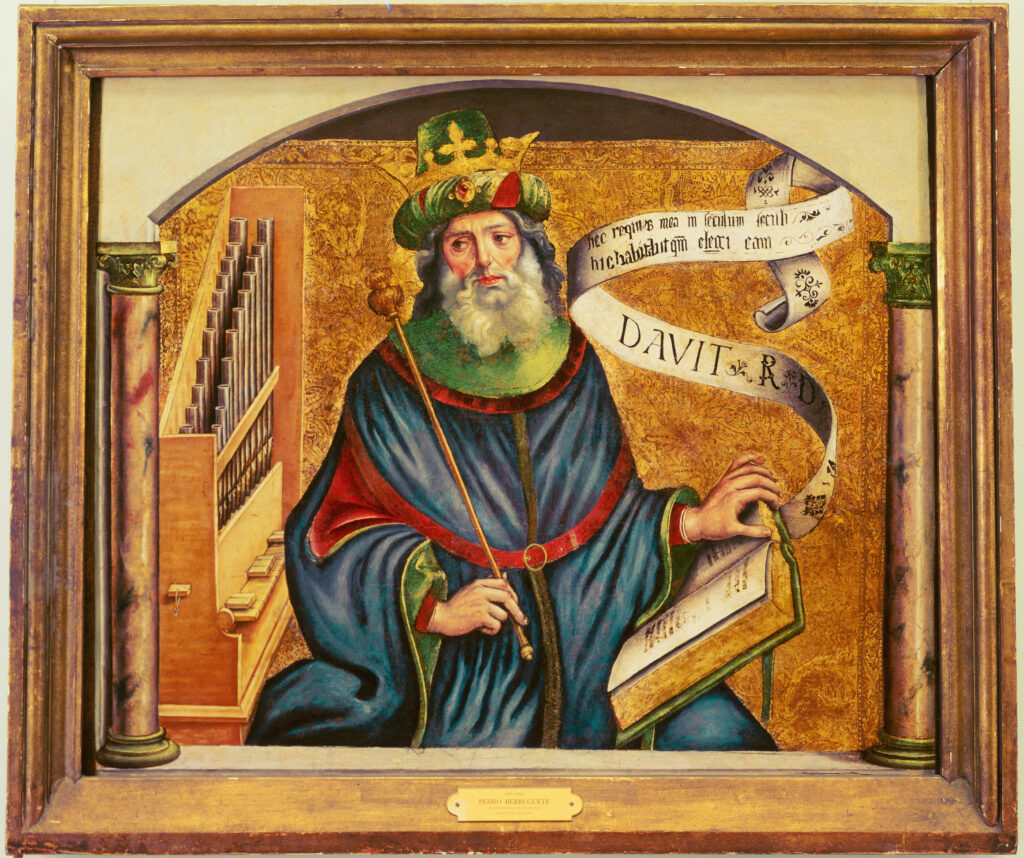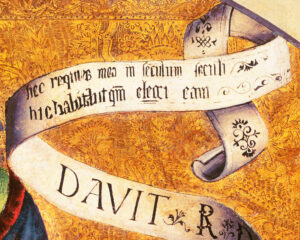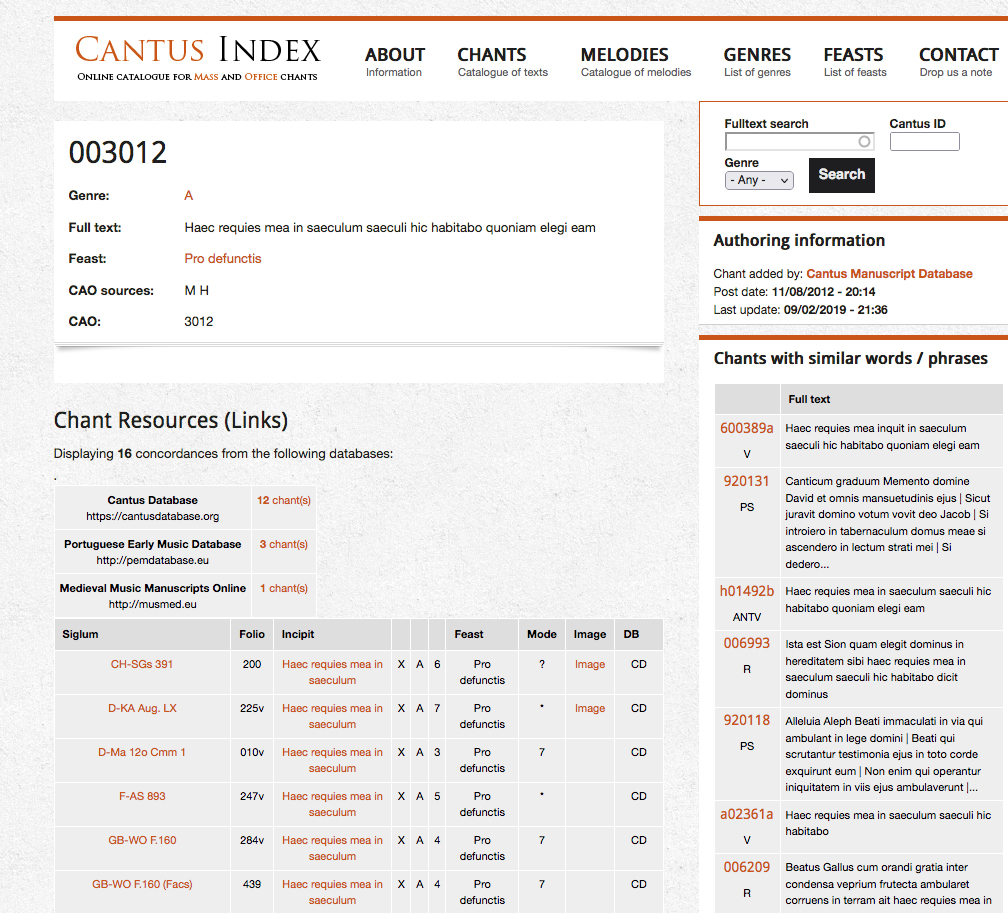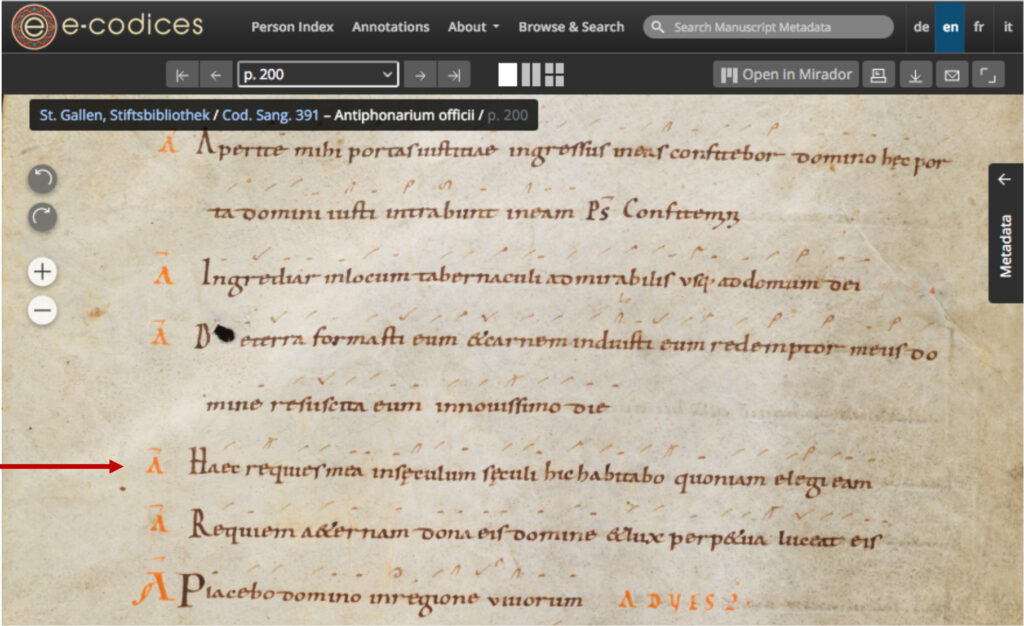As the BASIRA team continues adding works of art to the database, it’s often essential that we closely examine tiny details of the images. When an artist portrays even a fragment of text legibly, we can find rewarding connections. A recent entry led us to other digital humanities endeavors in almost startling ways. Thanks to extensive work by scholars from the University of Waterloo and Dalhousie University, the extraordinary Cantus database of Latin ecclesiastical chants allowed us to connect a two-dimensional visual resource with related textual, scribal, and even sonic contexts.
Our journey starts with Pedro Berruguete’s portrayal of King David, now residing in the Bowdoin College Museum of Art, in Brunswick, Maine.

The BASIRA entry for this work of art contains two linked document records: one each for the green book on the king’s left knee, and another for the banderole floating above it. The artist painted only a suggestion of (illegible) text on the open book, but he carefully presents clear words on the banderole:
h[a]ec requies mea in seculum seculi / hic habitabit qm elegi eam
[Translated as “This is my rest for the age of the age / I will dwell here, for I have chosen it.]”

An internet search of the phrase not only locates it in Psalm 131 [132], verse 14, but also takes us to the Cantus database of chants, where we learn that the phrase appears in the Mass of the Dead “Pro Defunctis.”*

If we follow the links provided by Cantus, we’d be able to locate not only the tonal pattern used to perform this chant, but also to examine its appearance in digitized manuscripts. Just some of the scholars who generously prepared the open resources gathered here include Joseph P. Metzinger, Lila Collamore, Keith Falconer, Richard Rice, “Marina Gallagher at the University of Waterloo, with editorial assistance from Debra Lacoste…. Melodies were entered by Shawn Henry and Joel Oliver-Cormier.”
https://cantus.uwaterloo.ca/indexer/670807
But wait, there’s more! The Cantus database also provides links to digitized manuscripts; one of these sends us to the site for e-codices https://www.e-codices.ch. The extraordinary collection of images gathered there has been underway since 2005, an initiative of Prof. Dr. Christoph Flüeler, Professor for Manuscript Studies and Medieval Latin and a member of the Medieval Institute at the University of Fribourg, with support from numerous organizations and foundations.
Thanks to their work, made available with a Creative Commons license, we encounter the psalmist’s phrase in the antiphonarium officii of St. Gallen, Stiftsbibliothek, ** a manuscript written on parchment between 990 and 1000.

We’ve now traveled from an image of a painting created — probably in Spain — between 1485 and 1490 to an edition of the Vulgate Bible; from there, we learned from the Cantus Index that the phrase appears in the Mass of the Dead. One of the instances of this Mass leads us to the site e-codices, where we’re able to see the phrase from King David’s banderole as it appeared in a manuscript written ca. 995 for the monks of St. Gallen, in what is now Switzerland.
Whether Berruguete intended King David’s banderole to be a citation from the Mass of the Dead in his painting would require much more investigation; his work with later stages of the Inquisition might have some bearing. Many works ascribed to Berruguete portray books and banderoles as “citations” of written culture. For now, our hats are off to the many, many generous and diligent researchers who have collected, transcribed, photographed, and built the databases and indexes that allow us to locate and follow such connections. We hope that, with time, the BASIRA Project will become an equally valuable resource.
Notes:
*Free access to the Cantus Index and Cantus Database is “in accordance with the aims of the International Musicological Society’s Study Group Cantus Planus” which began in 2001.
** Cod. Sang. 391, p. 200 – Antiphonarium officii (https://www.e-codices.ch/en/list/one/csg/0391).
